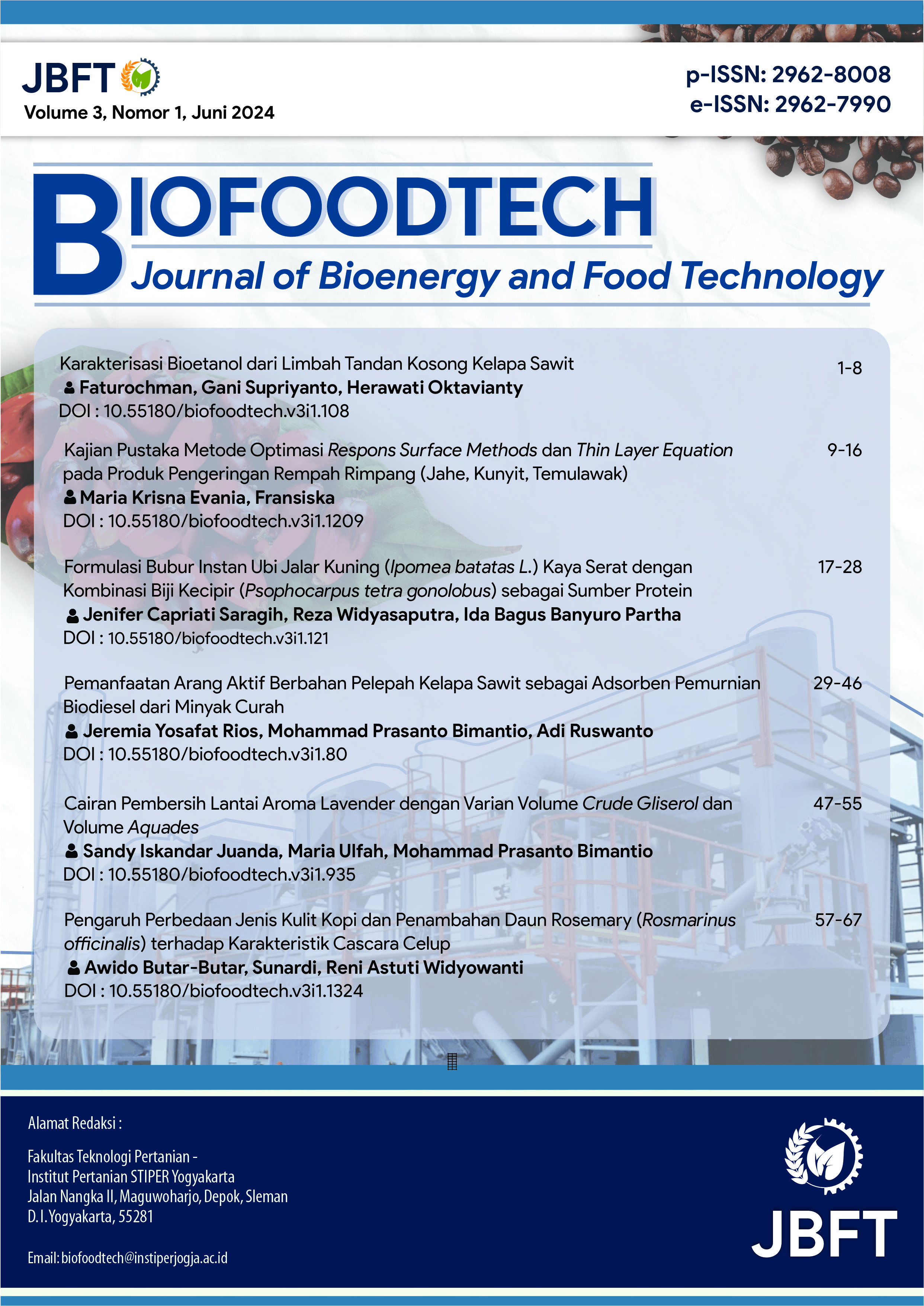Karakterisasi Bioetanol dari Limbah Tandan Kosong Kelapa Sawit
DOI:
https://doi.org/10.55180/biofoodtech.v3i1.1087Kata Kunci:
Bioethanol, characterization, palm empty fruit bunchAbstrak
At the moment, Indonesia still relies heavily on fossil fuels to cover its domestic energy demands. However, one of the main causes of the rise in greenhouse gas emissions is the nation's reliance on fossil fuels for energy damage to the environment. An alternate energy source is called bioethanol. The fermentation process of natural ingredients with the help of microorganisms, Bioethanol produced from biomass in this study is palm empty fruit bunches (PEFB) because of the cellulose content of 45.59% which can be converted into second-generation bioethanol. Poses for making bioethanol of PEFB through the process of pretreatment, hydrolysis, fermentation, and distillation. The purpose of this study is to determine the characteristics of bioethanol produced by PEFB waste. Bioethanol characteristic testing refers to test standards determined by SNI 7390:2008/2013, This study produced ethanol content of 4.92% in 6-day fermentation that did not meet the specified standards, methanol content produced 0.4% in 10-day fermentation and had met the specified standards, water content in 4-10 days fermentation produced 25.56%-30.72% did not meet the specified standards, denaturant content in 10-day fermentation produced 9% had met the specified standards. The fermentation of 6 days produced the best condition, obtaining 4.92% ethanol content and 25% moisture content. Still, it did not meet the specific standards of SNI 7390:2008, but met the SNI standards for the methanol content of 0.4%, denaturant level of 11%, acidity of 0.3 mg /L, chloride ion levels of 0.7 mg /L, sulphur content of 0.68 mg /L, and the sap content of 7 mg / l.
Referensi
Darsono, & Sumarti, M. (2014). Pembuatan Bioetanol dari Lignoselulosa Tandan Kosong Kelapa Sawit Menggunakan Perlakuan Awal Iradiasi Berkas Elektron dan NaOH. 36(2), 245–252.
Dhalika, T., Mansyur, & Budiman, A. (2012). EVALUASI KARBOHIDRAT DAN LEMAK BATANG TANAMAN PISANG (Musa paradisiaca. Val) HASIL FERMENTASI ANAEROB DENGAN SUPLEMENTASI NITROGEN DAN SULFUR SEBAGAI BAHAN PAKAN TERNAK. Pastura: Jurnal Ilmu Tumbuhan Pakan, 1(2), 97–101.
Hidayat, M. R. (2013). Teknologi Pretreatment Bahan Lignoselulosa dalam Proses Produksi Bioetanol. Biopropal Industri, 4(1), 33–48.
Iverson, B. L., & Dervan, P. B. (2011). Produksi Alkohol, Nilai pH, Dan Produksi Gas Pada Bioetanol Dari Susu Rusak Dengan Campuran Limbah Cair Tapioka. 1, 7823–7830.
Khairiah, N., Dahelmi, D., & Syamsuardi, S. (2012). Jenis-Jenis Serangga Pengunjung Bunga Pacar Air (Impatiens balsamina Linn. :Balsaminaceae). Jurnal Biologi Universitas Andalas, 1(1), 9–14.
Khodijah, S., & Abtokhi, A. (2015). Analisa Pengaruh Variasi Presentase Ragi (Saccharomycescerevisiae) Dan Waktu Pada Proses Fermentasi Dalam Pemanfaatan Duckweed (Lemna minor). Jurnal Neutrino, 71. https://doi.org/10.18860/neu.v0i0.2989
Ningsih, Y. A., Lubis, K. R., & Moeksin, R. (2012). Pembuatan Bioetanol Dari Tandan Kosong Kelapa Sawit (Tkks) Dengan Metode Hidrolisis Asam Dan Fermentasi. 18(1), 30–34.
Purwasih, R. (2017). Pemanfaatan Limbah Pabrik Brem Sebagai Bahan Baku Bioetanol Untuk Bahan Bakar Alternatif. Jurnal Pendidikan Teknik Mesin UNESA, 6(02), 25–36.
Sutrisna Wijaya, I. M. A., Arya Arthawan, I. G. K., & Novita Sari, A. (2012). Potensi Nira Kelapa Sebagai Bahan Baku Bioetanol. Jurnal Bumi Lestari, 12(1), 85–92.
Wusnah, W., Bahri, S., & Hartono, D. (2019). Proses Pembuatan Bioetanol dari Kulit Pisang Kepok (Musa acuminata B.C) secara Fermentasi. Jurnal Teknologi Kimia Unimal, 8(1), 48. https://doi.org/10.29103/jtku.v8i1.1915
Unduhan
Diterbitkan
Cara Mengutip
Terbitan
Bagian
Citation Check
Lisensi
Hak Cipta (c) 2024 BIOFOODTECH : Journal of Bioenergy and Food Technology

Artikel ini berlisensiCreative Commons Attribution-NonCommercial-ShareAlike 4.0 International License.











